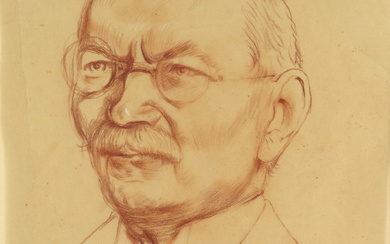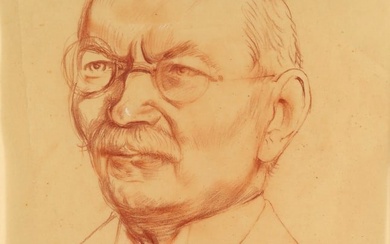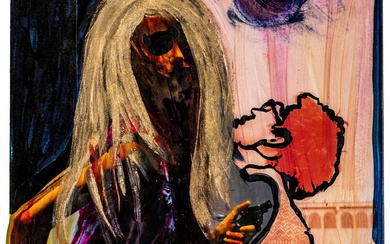Otto Dix, Gräben vor Reims I
Otto Dix
Untermhaus near Gera 1891 - 1969 Singen/Hohentwiel
Gräben vor Reims I
1916
Gouache on packing paper. 29 x 28 cm. Framed under glass. Unsigned. - Few very small losses of colour in the area of the pastose colours, partially with minute retouches.
Pfäffle G 1915/6
With a written confirmation from the artist (copy) Provenance
Private collection, Germany; Galerie Thomas, Munich (1998); Private collection, Rhineland; Private collection, South Germany Exhibitions
Hamburg 2007 (Bucerius Kunst Forum), Geisterbahn und Glanzrevue. Otto Dix. Aquarelle und Gouachen, cat. no. 10 with full-page colour illus. Literature
Dietrich Schubert, Ein unbekanntes Kriegsbild von Otto Dix. Zur Frage der Abfolge seiner Kriegsarbeiten 1915-1918, in: Jahrbuch der Berliner Museen, Jahrgang 1996, pp. 151 ff., p. 165 with colour illus.
Serving on the front in the First World War Otto Dix like so many members of his generation had expected a catharsis, a new beginning, in this extremely existential event: “The war was a hideous thing, but nonetheless something tremendous. I certainly couldn't miss out on it! You have to have seen people in this uninhibited state in order to know something about people. Perhaps you have to have participated directly.” (Otto Dix in conversation with Hans Kinkel, Stuttgarter Zeitung, 1 Dec 1961, cited in: Brigitte Reinhardt, Dix Maler der Tatsachen, in: Otto Dix: Bestandskatalog der Staatsgalerie Stuttgart, Stuttgart 1989, p. 12).
The reality of that war would soon replace Dix's euphoria and shape him for the rest of his life. In France and Russia he registered the routines of soldiers' daily lives and used pencil, charcoal or chalk to draw on hundreds of field postcards. Less frequently he created gouaches which shed light on the horrors of war in luminous colours applied to small square sheets of paper. As a whole his works provide a unique visual diary somewhere between reporting and reflecting.
In a letter to Helene Jakob Dix describes the hostile fortifications "as an enormous map [...] only the labyrinthine dugouts and corridors ascending in white colour from the grenish grey of the soil." (Cited in Dietrich Schubert, Künstler im Trommelfeuer des Krieges 1914-18, Heidelberg 2013, p. 215). Dix painted the “Gräben von Reims” as a light-filled phantasmagoria - a glaringly lit, deformed landscape beneath the sky's dramatically parting clouds. No people can be seen in this landscape cleansed of the loud chaos of battle. Torn apart and nonetheless entirely calm, almost still, it spreads out towards the horizon, simultaneously a haunting apocalypse and pastoral idyll. Formally Dix's works of these years are shaped by his occupation with Expressionism and Futurism. The artificial use of colour can also be understood in this context: primarily through the loosely dabbed passages, it stirs associations with a flowering springtime landscape, thus further underscoring the image's unreal aspect.
View it on
Sale price
Estimate
Time, Location
Auction House
Otto Dix
Untermhaus near Gera 1891 - 1969 Singen/Hohentwiel
Gräben vor Reims I
1916
Gouache on packing paper. 29 x 28 cm. Framed under glass. Unsigned. - Few very small losses of colour in the area of the pastose colours, partially with minute retouches.
Pfäffle G 1915/6
With a written confirmation from the artist (copy) Provenance
Private collection, Germany; Galerie Thomas, Munich (1998); Private collection, Rhineland; Private collection, South Germany Exhibitions
Hamburg 2007 (Bucerius Kunst Forum), Geisterbahn und Glanzrevue. Otto Dix. Aquarelle und Gouachen, cat. no. 10 with full-page colour illus. Literature
Dietrich Schubert, Ein unbekanntes Kriegsbild von Otto Dix. Zur Frage der Abfolge seiner Kriegsarbeiten 1915-1918, in: Jahrbuch der Berliner Museen, Jahrgang 1996, pp. 151 ff., p. 165 with colour illus.
Serving on the front in the First World War Otto Dix like so many members of his generation had expected a catharsis, a new beginning, in this extremely existential event: “The war was a hideous thing, but nonetheless something tremendous. I certainly couldn't miss out on it! You have to have seen people in this uninhibited state in order to know something about people. Perhaps you have to have participated directly.” (Otto Dix in conversation with Hans Kinkel, Stuttgarter Zeitung, 1 Dec 1961, cited in: Brigitte Reinhardt, Dix Maler der Tatsachen, in: Otto Dix: Bestandskatalog der Staatsgalerie Stuttgart, Stuttgart 1989, p. 12).
The reality of that war would soon replace Dix's euphoria and shape him for the rest of his life. In France and Russia he registered the routines of soldiers' daily lives and used pencil, charcoal or chalk to draw on hundreds of field postcards. Less frequently he created gouaches which shed light on the horrors of war in luminous colours applied to small square sheets of paper. As a whole his works provide a unique visual diary somewhere between reporting and reflecting.
In a letter to Helene Jakob Dix describes the hostile fortifications "as an enormous map [...] only the labyrinthine dugouts and corridors ascending in white colour from the grenish grey of the soil." (Cited in Dietrich Schubert, Künstler im Trommelfeuer des Krieges 1914-18, Heidelberg 2013, p. 215). Dix painted the “Gräben von Reims” as a light-filled phantasmagoria - a glaringly lit, deformed landscape beneath the sky's dramatically parting clouds. No people can be seen in this landscape cleansed of the loud chaos of battle. Torn apart and nonetheless entirely calm, almost still, it spreads out towards the horizon, simultaneously a haunting apocalypse and pastoral idyll. Formally Dix's works of these years are shaped by his occupation with Expressionism and Futurism. The artificial use of colour can also be understood in this context: primarily through the loosely dabbed passages, it stirs associations with a flowering springtime landscape, thus further underscoring the image's unreal aspect.






